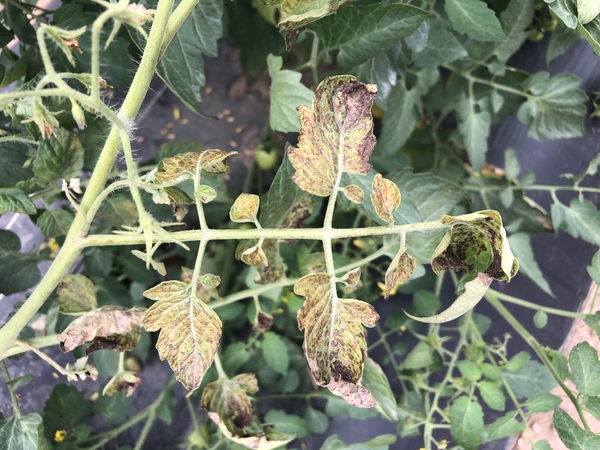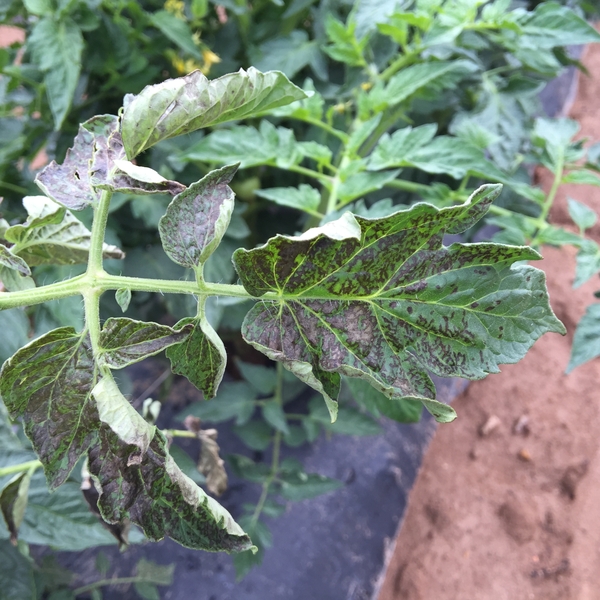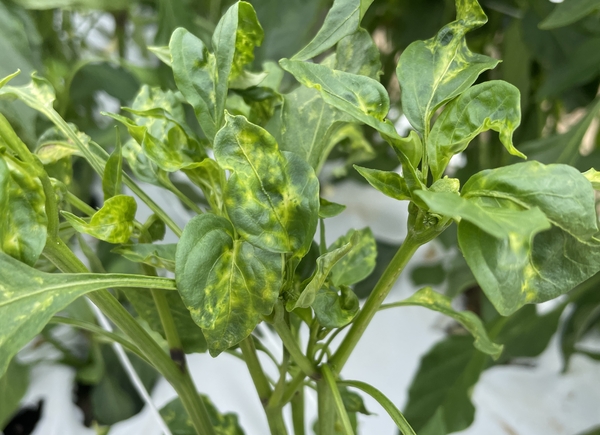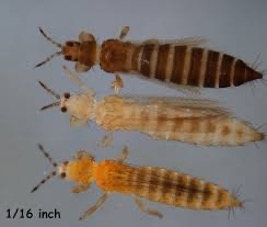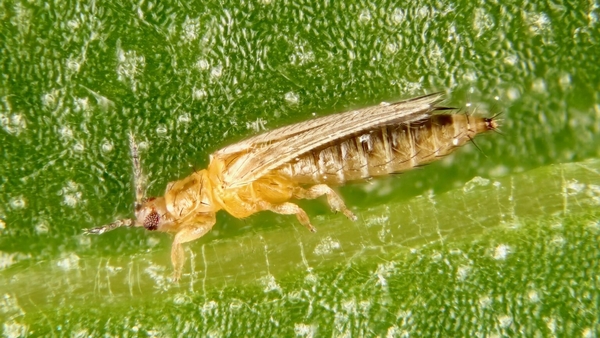Introduction
Tomato spotted wilt virus (TSWV) is an important pathogen that causes disease in numerous crops, especially tomatoes and peppers. Resistance-breaking variants of TSWV were discovered in NC on tomato varieties with the Sw-5 resistance gene during the summer of 2022. Given that host resistance is currently the most effective management strategy of TSWV, these strains pose a great threat to tomato production in the coming years. This article will focus on TSWV identification and management strategies for tomatoes and peppers.
Pathogen
TSWV is a member of the genus, Orthotospovirus—a group of plant viruses vectored by arthropods, usually thrips. Currently, many tomato and pepper hybrid cultivars include a single gene for resistance to TSWV (Sw-5 in tomatoes and Tsw in peppers). In June of 2022, two different resistance breaking variants of the virus were detected—each on a separate, but nearby, tomato farm in NC on tomato cultivars with the Sw-5 resistance gene. These variants have been detected on tomato in subsequent years suggesting that they can persist in the environment. Therefore, it is recommended that growers monitor their tomato seedlings and plants for symptoms of TSWV. It is important to note that the genes for resistance are not expressed in flowers and fruit (only in foliage), and given that thrips prefer flowers it is possible to see symptoms on fruit of a resistant plant. This would not be considered a resistance breaking variant unless symptoms also occur on the foliage. If you suspect TSWV regardless of variety, contact your local extension agent or NCDA agronomist and submit samples through the NC State Plant Disease and Insect Clinic. See this article for more information regarding TSWV resistance breaking variants.
Host Range
TSWV has one of the widest host ranges among plant viruses. The pathogen infects more than 1,000 plant species among 85 families. In NC, it infects crops such as tomatoes, peppers, tobacco, potatoes, eggplants, squashes, lettuce, onions, spinach, and herbs like peppermint. Floriculture crops, such as begonias, impatiens, and many other bedding plants, are also susceptible. Several weed species can also harbor the virus allowing it to overwinter and spread onto field crops each growing season.
Signs and Symptoms
On tomatoes infected with TSWV, the uppermost leaves appear bronzed with small brown lesions (Figure 1). Infected peppers form small brown necrotic spots and/or chlorotic ring spots on the foliage (Figure 2). Infected foliage on both tomatoes and peppers may become covered with so many spots that the entire leaf browns, rolls, and wilts. Infected seedlings form a “shepherd’s crook” appearance and die (Figure 3). Early infection results in total loss of fruit. Established plants that become infected are stunted with decreased yields. Symptoms on the fruit of both tomatoes and peppers typically include yellow ringspots and brown necrotic sunken areas (Figures 4 and 5). Keep in mind that some of these symptoms overlap with other plant viruses so it is important to get an accurate diagnosis for effective management.
Disease Diagnosis
Agdia ImmunoStrip® is a test strip that is similar to a COVID-19 test strip that can be used in the field to confirm the presence of TSWV within minutes. Symptoms of TSWV can be variable and some are similar to symptoms of other viruses, so it is important to ensure accurate diagnosis before implementing management strategies. Symptoms of TSWV may also resemble symptoms of early blight or other leaf spot diseases; however, lesions caused by TSWV have blurred margins, while the margins of lesions caused by other diseases are definite.
Disease Cycle and Epidemiology
TSWV is transmitted by thrips, small slender insects (1-2 mm in length) insects in the order, Thysanoptera. The virus can be vectored by at least 10 different species of thrips. However, in NC and surrounding states, the tobacco thrips (Frankliniella fusca) and western flower thrips (F. occidentalis) are the only vectors of consequence. The virus is acquired by the larval stage (first stage after hatching from eggs) when they feed on a TSWV-infected plant. The virus then replicates within the thrips as it matures, is transmitted by adults when they feed on plants. Once a plant is infected, there is no cure; there are only strategies to minimize the future impact of the virus. Plants will be asymptomatic for a period after inoculation, so virus symptoms may not be visible until days or weeks after transmission has occurred.
The tobacco thrips is dark brown to black in color (Figure 6) and is important in the primary spread of the virus (spread from weed hosts to the crop during the first few weeks after transplanting). Tobacco thrips is common during the spring months (April and May), after which populations decline. Western flower thrips (WFT) are light yellow to cream colored and most common from May (Piedmont and Coastal Plains) or June (Mountains) through July, but can persist into October. WFT is important in the secondary spread of TSWV (spread from plant to plant within a field). It is also capable of transmitting the virus to tomato fruit of TSWV-resistant cultivars when feeding on flowers because the Sw-5 gene is not expressed in the reproductive tissues (flowers and fruit) of tomatoes.
The flower thrips (F. tritici), also called the eastern flower thrips, is another common species on tomatoes and peppers, and is similar in appearance to WFT, but it does not transmit TSWV.
Disease Management for Commercial Growers
The most effective management practice is the combined use of the strategies (integrated pest management) detailed below. Total elimination of thrips is not practical; however, with proper management, thrips populations can be minimized to help prevent and reduce the spread and damage of TSWV. Prevention is always the most effective form of control
Prevention and Management
- Deploy TSWV resistant varieties. When purchasing tomatoes and peppers, select varieties with the Sw-5 and Tsw genes, respectively. Although resistance-breaking variants have been found, it has only occurred in one county in NC, so growers should continue to seek host resistance to complement other cultural practices mentioned below.
- Insecticides. Chemical control of thrips can help to reduce the spread of TSWV, but it is only partially effective in reducing virus incidence of virus. Treating transplants with imidacloprid just before setting in the field is one of the most effective approaches to suppress primary spread; Research suggests this can reduce TSWV incidence by up to 50%. Control of WFT can be difficult, because there are few insecticides that provide effective control, and in some areas it has developed resistance to certain insecticides. Insecticides are more effective at controlling thrips feeding on foliage than in flowers.
- Use reflective mulch. Planting on reflective mulches, which disorients and prevents thrips from landing on plants, has been an effective strategy for reducing thrips populations on tomatoes compared to black and white plastic. In fact, thrips populations are typically highest on white plastic. Reflective mulches are more expensive than black or white plastic, so this strategy should be reserved for fields with a history of high infestations of thrips.
- Control weeds. Weeds provide a refuge for thrips populations to increase populations and infect nearby crops. We specifically recommend controlling weeds such as dandelions, sow thistle, chickweed, buttercup, and plantain.
- Segregate externally sourced plant material. Because TSWV can be introduced to a new area by infected plant material, quarantine newly purchased plants until you are sure they are disease and insect free. Inspect transplants for symptoms before planting and discard symptomatic plants.
- Use biological control methods. Natural enemies can reduce thrip populations and help to reduce reliance on insecticidal control. Minute pirate bugs (Orius insidious) and big-eyed bugs (Geocoris punctipes) are predators of thrips and can be effective biological control agents on peppers. Unfortunately, these predators do not do well on tomatoes and eggplant.
- Minimize thrips entry in greenhouses. Absolute control of thrips in a greenhouse environment is not possible, but use of thrips-proof screening on air intakes and vents can be highly effective as a physical barrier to prevent thrips from entering greenhouses. Holes in screening must be less than 169 micros, or mesh with no more than 100 holes per square inch. If your space allows, double door entries add another layer of protection.
- Incoming plants can also harbor and introduce thrips to a greenhouse, so screening incoming plants is also important.
- Monitor thrips in the greenhouse. Early detection of thrips and the virus is crucial. Sticky yellow card traps allow you to track thrips and other insect populations. When populations begin to grow, use insecticides.
- Avoid growing ornamentals and vegetables in the same greenhouse. Many ornamental plants are hosts of TSWV and some can be asymptomatic carriers. It is best to avoid growing ornamentals and vegetable transplants in the same greenhouse to avoid spreading the virus among these crops.
Disease Management for Home Gardeners
If TSWV or thrips populations are not severe, home gardeners may not need to manage this disease. If TSWV has been a problem in previous years, resistant varieties are still the best management option for home gardeners. Spraying tomatoes early in the season with neem oil or other botanical insecticides may help control thrips. Additionally, summer oil or insecticidal soap may be used. Read and follow product label instructions carefully before using any crop protection materials in your home garden.
Additional Resources
- The NC State Plant Disease and Insect Clinic provides diagnostics and control recommendations.
- The NC State Extension Plant Pathology Portal provides information on crop disease management.
- The Southeastern US Vegetable Crop Handbook provides information on vegetable disease management.
Acknowledgements
This factsheet was reviewed and improved with the help of Jim Walgenbach.
Publication date: July 1, 2024
N.C. Cooperative Extension prohibits discrimination and harassment regardless of age, color, disability, family and marital status, gender identity, national origin, political beliefs, race, religion, sex (including pregnancy), sexual orientation and veteran status.

